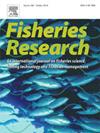Population structure of the Chub mackerel Scomber japonicus, in waters of the northwest of Mexico
IF 2.3
2区 农林科学
Q2 FISHERIES
引用次数: 0
Abstract
Understanding the population structure of commercially harvested species is essential for the effective management of fisheries. The Chub mackerel (Scomber japonicus) is a significant fishery resource in the Mexican Pacific. It exhibits two distinct population units delineated by temporal variations in gonadal maturity stages and spawning seasons, and other features as age and size composition. However, the species' highly migratory behavior may contribute to genetic homogeneity, similar to what has been observed in other small pelagic species. This study aimed to test whether the Chub mackerel presents a discrete population by integrating body morphological (geometric morphometric) and genomic (SNP´s) variability analyses. Fish analyzed were collected in Ensenada, Bahía Magdalena, Mazatlán, and the Gulf of California center from autumn 2020 to spring 2021 (N = 291). The body morphological variability (geometric morphometrics) allowed us to differentiate between two morphotypes: one with an elongated and hydrodynamic shape related to the areas with higher current intensity, followed by weaker covariation with increasing temperature; and the second, with a shorter head associated with less dynamic waters and sea surface height increased. However, the population genomic analysis with 4877 neutral SNPs showed a single population in the Mexican Pacific. These results indicate that the Chub mackerel presents a single population with two morphotypes linked to the variability of ocean dynamics.
墨西哥西北部水域鲭鱼的种群结构
了解商业捕捞物种的种群结构对渔业的有效管理至关重要。鲐鱼是墨西哥太平洋重要的渔业资源。它表现出两种不同的种群单位,由性腺成熟期和产卵季节的时间变化以及年龄和大小组成等其他特征所描绘。然而,该物种的高度迁徙行为可能有助于遗传同质性,类似于在其他小型远洋物种中观察到的情况。本研究旨在通过整合身体形态(几何形态计量学)和基因组(SNP)变异性分析来检验鲐鱼是否呈现离散种群。分析的鱼类于2020年秋季至2021年春季在Ensenada, Bahía Magdalena, Mazatlán和加利福尼亚湾中心收集(N = 291)。身体形态变异(几何形态计量学)使我们能够区分两种形态:一种是与高电流强度区域相关的细长和流体动力学形状,随后随着温度的升高而减弱;第二,头部较短的人,与动态水域较少有关,海面高度增加。然而,具有4877个中性snp的群体基因组分析显示,墨西哥太平洋是一个单一的群体。这些结果表明,与海洋动态变化有关的鲐鱼呈现出单一种群的两种形态。
本文章由计算机程序翻译,如有差异,请以英文原文为准。
求助全文
约1分钟内获得全文
求助全文
来源期刊

Fisheries Research
农林科学-渔业
CiteScore
4.50
自引率
16.70%
发文量
294
审稿时长
15 weeks
期刊介绍:
This journal provides an international forum for the publication of papers in the areas of fisheries science, fishing technology, fisheries management and relevant socio-economics. The scope covers fisheries in salt, brackish and freshwater systems, and all aspects of associated ecology, environmental aspects of fisheries, and economics. Both theoretical and practical papers are acceptable, including laboratory and field experimental studies relevant to fisheries. Papers on the conservation of exploitable living resources are welcome. Review and Viewpoint articles are also published. As the specified areas inevitably impinge on and interrelate with each other, the approach of the journal is multidisciplinary, and authors are encouraged to emphasise the relevance of their own work to that of other disciplines. The journal is intended for fisheries scientists, biological oceanographers, gear technologists, economists, managers, administrators, policy makers and legislators.
 求助内容:
求助内容: 应助结果提醒方式:
应助结果提醒方式:


